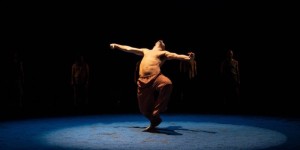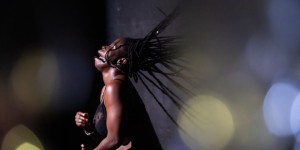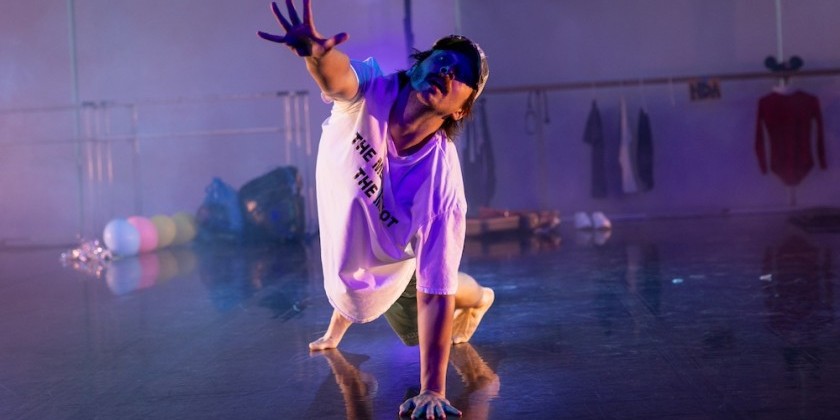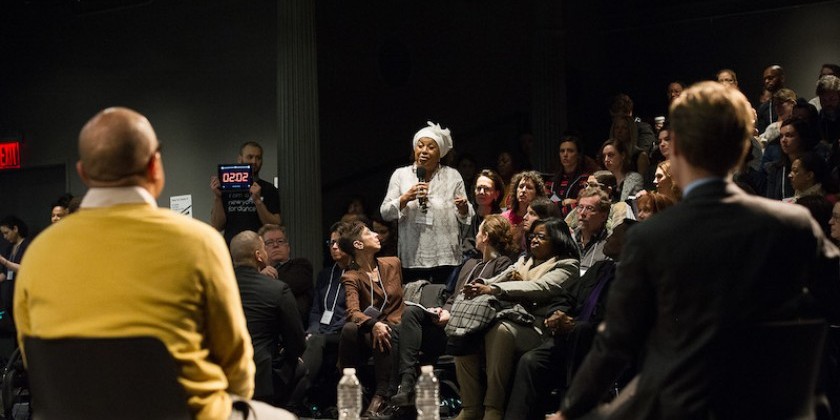BOOM! A Choreography of Shifting Realities -- Coming To New York Live Arts.
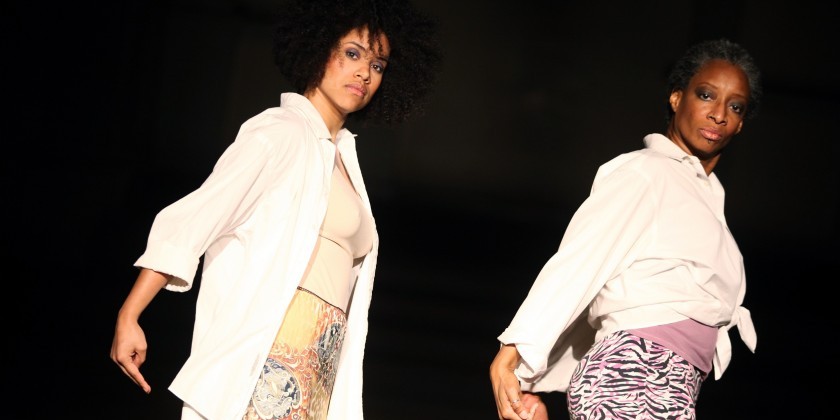
For tickets and more information on BOOM!, which will premiere at New York Live Arts October 23-25, visit http://newyorklivearts.org/event/boom.
When I first met Cynthia Oliver at the beginning of this year, I never would have guessed that she was a breast cancer survivor. I remember encountering a beautiful, black woman at choreographer, Camille A. Brown’s The Gathering -- an annual convening for inter-generational black female artists to support one another. Oliver spoke with clarity there about her role as both artist and professor and the expectations of academia. Little did I know, her talking points would be present in her newest work, BOOM!, which will premiere in evening-length form at New York Live Arts, October 23-25.
BOOM!, performed by Oliver and long-time collaborator Leslie Cuyjet, is not a black woman’s declarative manifesto about breast cancer survival, rather the work is an intimate, honest exploration of survival, reality, and questioning. I had the pleasure of chatting with both Oliver and Cuyjet not only about the creative process and journey of this work, but also about black womanhood and survival in life, dance, and performance.
“I was diagnosed with breast cancer in 2010...this was at the end of touring my last piece,” discloses Oliver. She began creating BOOM! in 2012 after concluding her cancer treatment. On beginning the creative process, the choreographer says, “I knew that I wanted to make this intimate piece of work, and that a duet would be ideal. This piece was my coming back to my body...and I wanted to make sure that it was something I could handle. So for a lot of reasons, practical and creative, I decided to make it a small endeavor. I knew I was working on ideas around differences of self over time, and as I thought of who would suit the work best, Leslie came to mind. This is a person who I'm comfortable with, whose creativity I adore, whose judgment and artistic ideas I also trust and value."

Cuyjet and Oliver continue a long creative relationship that began when Cuyjet was a student at the University of Chicago. Oliver came to that school as a professor in 2000 where Cuyjet was a sophomore. Oliver invited her to dance in a new work. It was Cuyjet’s first experience with text and movement, and she must have enjoyed it because she’s been performing with Oliver since. Twelve years later, Cuyjet has come to see Oliver as her mentor. This relationship has informed Cuyjet’s performance, as well as her personal choreographic process.
Cuyet describes having doubts as an artist, questioning her intuition and ideas while entering her work. She admires Oliver’s confidence. “I’m experiencing how she stakes her claim and ‘uses’ her ideas in dance and performance as a tool, as a weapon. That's got to be the most inspiring.”
With this intimacy, admiration, and understanding, the two women stepped into BOOM! or, as Oliver describes it, “a choreography of shifting realities” -- realities framed around the ideas of self over time along with the experiences of discovering and treating breast cancer. Coming out of the cancer experience," says Oliver, " It's like – I did everything right. I ate the right food. I exercised. I put myself in all these situations that were supposed to be healthy. I'm not consciously saying that I tried to avoid cancer, but that these are the things that should made it turn out a certain way. And it didn't. So what do you do with that? How do you reconcile yourself? I never thought, why me, because that would indicate it should happen to someone else. Why not me? It is that kind of reckoning with fate, with what happens to whom, why, and when. No rhyme or reason. It's just the cards you're dealt and how you manage them."

What fascinates me is that the ideas present in BOOM!'s choreography came out of organic conversation and play, where personal lives and professional lives intertwined. There was a deep need for laughter amidst the stark honesty and challenging questions brought up. Equally important to the discussions during creation were the realities of black female experience. Says Cuyet, “Our process was to go into the studio for six hours and just hang out, talk, (and) exchange ideas about our lives, the climate of the dance culture and the dance field… Cynthia’s story is just a part of her experience in this world as a black female artist. She gave me access to identify, in my own story, all my low points, just like cancer is one of her low points.”
Oliver loves language as much as she loves movement, and the use of it has become a natural part of her dance making. While she is aware that dance may not need text, she is interested in providing a layered experience for the viewer and wants to “communicate on a number of levels simultaneously.” In BOOM!, Oliver challenged herself to confine her use of text, saying, “I wanted to make sure that I wasn't just hanging on it, but that it (the text) had its own place for a very particular reason. There’s a lot of the piece where there is no text. When it does come, it has a real punch and power to it.”
Limiting the use of text was not the only parameter Oliver gave herself. After two performances of the twenty-minute iteration of BOOM! , the first, at the invitation of Bebe Miller and Ishmael Houston-Jones’ PLATFORM 2012: Parallels at Danspace Project, and the second, at the request of Dance Theater Workshop’s (now New York Live Arts) Artistic Director Carla Peterson. Peterson invited Oliver to create an evening-length version of the work, but Oliver she knew the shorter version was complete, and she challenged herself not to tamper with it.
“I could've gone back in... and opened it up, and changed it,” says the choreographer, "but I wanted to keep it as it was and ask myself ... ‘What is next to consider physically, emotionally? Where would I go from here?’ … I discovered that I have a lot more to say.”
The performance experience will be framed by a Come Early Conversation led by Nia Love and a Stay Late Discussion with Jaamil Olawale Kosoko, both members of Oliver’s tribe who understand “on a very deep level the aesthetic from which I was working, the direction of my work, and the history of the work I've been making.”




